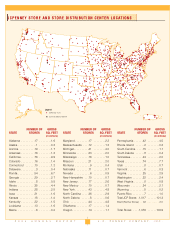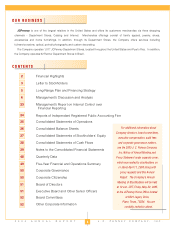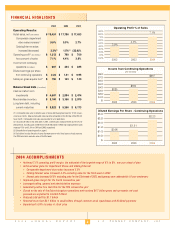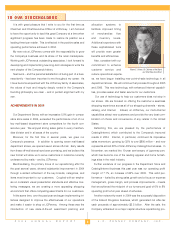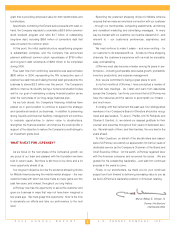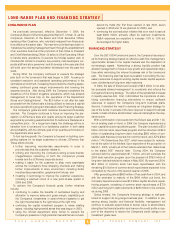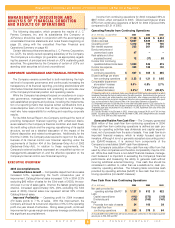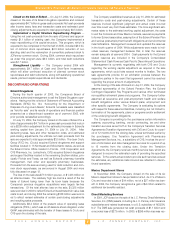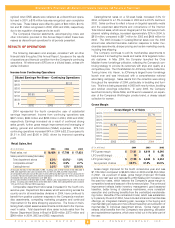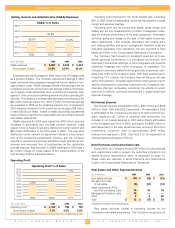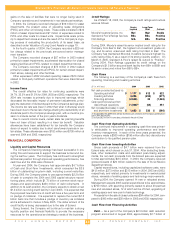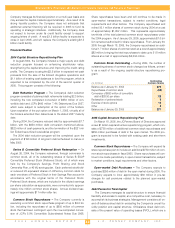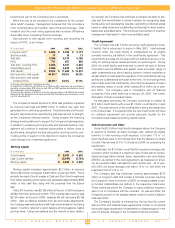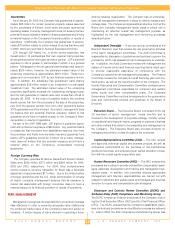JCPenney 2004 Annual Report Download - page 7
Download and view the complete annual report
Please find page 7 of the 2004 JCPenney annual report below. You can navigate through the pages in the report by either clicking on the pages listed below, or by using the keyword search tool below to find specific information within the annual report.
J.C. PENNEY COMPANY, INC.2 004 ANNUAL REPORT
5
LONG-RANGE PLAN
As previously announced, effective December 1, 2004, the
Company’s Board of Directors appointed Myron E. Ullman, III, as the
Company’s Chairman of the Board and Chief Executive Officer,
replacing Allen Questrom, who voluntarily resigned from these posi-
tions effective the same date. The near-term priorities have been to:
1) stabilize the existing management team through the establishment
of an executive board and the promotion of Ken Hicks to President
and Chief Merchandising Officer; 2) select a Chief Operating Officer
to handle store operations; 3) execute the holiday season well; 4)
introduce Mr. Ullman to investors, key vendors, mall developers, cor-
porate staff and store personnel; and 5) develop a five-year plan that
will build upon the strong foundation developed over the past four
years.
During 2004, the Company continued to execute the strategic
plan built on the turnaround that was begun in 2001, focusing on
consistent execution and sustained operating performance in the
centralized environment, increasing the productivity of selling space,
making continued gross margin improvements and lowering the
expense structure. Also during 2004, the Company completed the
divestiture of the Eckerd drugstore operations, which has allowed
management to focus fully on the operations of the Department
Stores and Catalog/Internet. The $3.5 billion in net after-tax cash
proceeds from the Eckerd sale is being utilized to execute a capital
structure repositioning program discussed under Financing Strategy.
The Company’s goals are both customer-focused and financially
oriented. The Company continues to focus on improving the per-
ception of JCPenney’s style and quality among its target customer
segments by providing assortments that fit customers’ lifestyles at a
competitive price. On a longer-term basis, the challenge will be to
transition from a turnaround to a leadership position in both sales
and profitability, with the ultimate goal of top quartile performance in
the department store sector.
To fuel top-line growth, the Company is focused on building com-
pelling reasons for its target customers to choose JCPenney first.
These efforts include:
•further improving merchandise assortments in order to
provide style that the customer relates to;
• refining and improving the Company’s strong private brands;
image/lifestyle marketing of both the Company’s private
brands and the JCPenney corporate brand;
•making it easier for the customer to shop more seamlessly
across the Company’s three shopping channels and making
further improvements to store environment, including better
merchandise presentation, graphics and fixtures; and
•investing in technology to improve the customer experience,
including a planned rollout of a new point-of-sale system in
2005 and 2006.
To achieve the Company’s financial goals, further initiatives
include:
•continuing to realize the benefits of centralized buying and
allocation to improve sales and gross margin, capitalizing on
the Company’s investments in state-of-the-art systems to get
the right merchandise to the right store at the right time;
•continuing the capital investment program to renew existing
space, including high-potential stores that was begun in 2003;
•using the off-mall department store format to expand the
Company’s presence in high potential markets that are not well-
served by malls (the first three opened in late 2003, seven
opened in 2004 and 12 are planned for 2005); and
•continuing the cost reduction initiative that is on track to save at
least $200 million annually, offset by planned investments.
SG&A expenses are expected to increase 1.0% to 1.5% but
be leveraged by higher sales.
FINANCING STRATEGY
Over the 2001-2004 turnaround period, the Company has execut-
ed its financing strategy based on effective cash flow management,
opportunistic access to the capital markets and the disposition of
non-strategic assets. Maintaining a strong liquidity position has
allowed management to focus on key growth and operational objec-
tives while minimizing the inherent business risk of the turnaround
plan. The financing plan has been successful in providing the nec-
essary resources to support working capital needs, capital expendi-
tures, dividends and long-term debt maturities.
In 2004, the sale of Eckerd and receipt of $3.5 billion in net after-
tax proceeds allowed management to re-evaluate and refocus the
Company’s financing strategy. The effect of the substantial increase
in liquidity was two-fold. First, it diminished the importance of iden-
tifying cost-effective financing alternatives to ensure sufficient
resources to support the Company’s long-term business plans.
Second, it elevated the need to develop an integrated strategy for
use of the funds, in excess of the level required to support business
needs, to best enhance stockholders’ value and strengthen the cap-
ital structure.
With a combination of proceeds from the Eckerd sale and $1.1 bil-
lion of existing cash on hand, in 2004, the Company implemented a
major capital structure repositioning plan. The plan included a $3.0
billion common stock repurchase program and the retirement of $2.3
billion of outstanding long-term debt, including $650 million of con-
vertible debt that was converted into common stock, and JCP’s $400
million 7.4% Debentures Due 2037, which were subject to redemp-
tion at the option of the holders. Upon expiration of the put option on
March 1, 2005, virtually all of the holders extended their debentures
to the stated 2037 maturity date. During 2004, the Company
reduced debt by approximately $1.7 billion, and will complete the
2004 debt reduction program upon the payment of $193 million of
long-term debt scheduled to mature in May 2005. By year-end 2004,
$2.0 billion of common stock had been repurchased, with the
remaining $1.0 billion of common stock repurchases expected to be
completed by the end of the second quarter of 2005.
After generating almost $600 million of free cash flow in 2004, and
with the extension to maturity of the $400 million put bond, the
Company has announced a new $1.0 billion capital structure reposi-
tioning program, consisting of common stock repurchases of $750
million and long-term debt retirements of $250 million to be complet-
ed during 2005.
Going forward, the Company’s financing strategy is well-posi-
tioned to support its long-range business plan. In addition to pre-
serving strong liquidity and financial flexibility, management will
continue to evaluate opportunities to deliver value to stockholders,
strengthen the financial position and improve the credit profile in sup-
port of the objective to restore the Company’s credit ratings to an
investment grade level.
LONG-RANGE PLAN AND FINANCING STRATEGY


